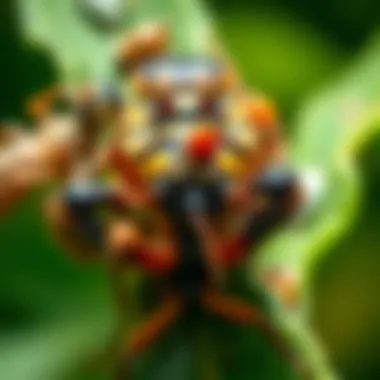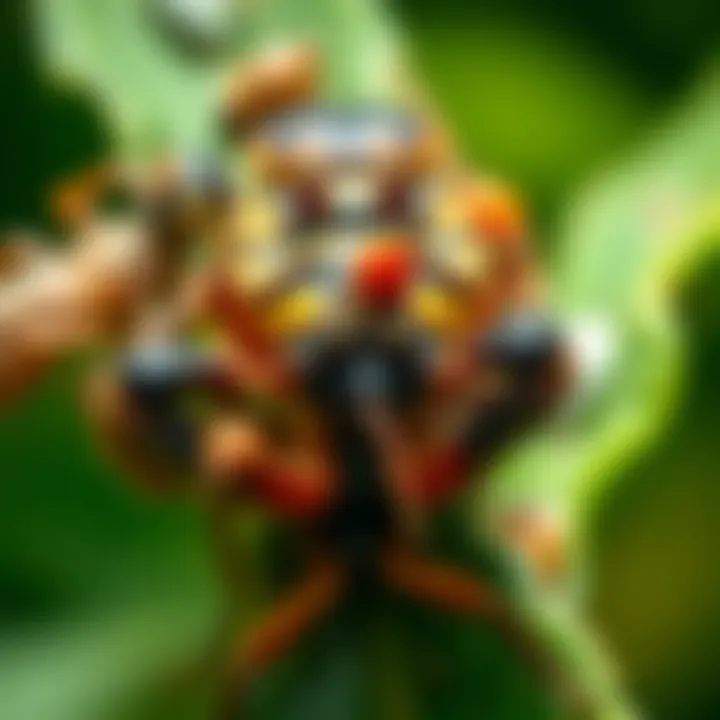Understanding the Costs of Responsible Pest Control


Intro
Navigating the realm of pest control can sometimes feel akin to negotiating a minefield. When pests invade your home, you’re not just dealing with the stress of infestation, but also the daunting task of prices and services that come along with it. Understanding how and why pest control prices fluctuate is critical for homeowners and families aiming to blend affordability with efficiency. In this piece, we’re cutting through the complexities to offer a clear lens on responsible pest control pricing.
Pest Identification
Detailed Descriptions of Common Pests
The first step in any effective pest control strategy is identifying the kind of pest causing trouble in your space. Here’s a brief look at some of the most common nuisances:
- Cockroaches: Sleek and quick, these brown or black insects thrive in warm, dark spaces. They’re not just gross; they can spread diseases.
- Termites: Often called "silent destroyers," these little critters feast on wood, which can lead to serious structural damage.
- Ants: Various species exist, from the minute pharaoh ant to the industrious carpenter ant, each with its own quirks and nests.
- Bed Bugs: These are small, elusive insects that feed on human blood, typically hiding in mattresses or furniture.
Signs and Symptoms of Infestations
Identifying a pest issue early is vital. Be on the lookout for the following signs:
- Droppings or fecal matter, which resemble tiny grains of rice for roaches or dark, puffy pellets for mice.
- Gnaw marks or noticeable damage to wooden structures can be a signal that termites are hard at work.
- Unusual sounds, like scratching at night, could indicate rodents hidden within your walls.
- Bites or itchy spots on your body when you wake up might be a cue that bed bugs have set up shop in your home.
"Early detection is half the battle when it comes to managing pests efficiently."
Prevention Strategies
Home Maintenance Tips for Pest Prevention
A proactive approach to pest control not only saves you money in the long run but also enhances your living environment. Here are some practical measures:
- Seal cracks and crevices. Check for gaps around windows, doors, and foundations where pests might sneak in.
- Maintain cleanliness. Regularly cleaning your home, especially the kitchen, will make it less inviting to pests. Store food in airtight containers and promptly clean up spills.
- Manage moisture. Pests love damp environments. fix leaking pipes and use dehumidifiers when needed.
Natural Deterrents and Barriers
Rather than relying solely on harsh chemicals, consider these natural deterrents:
- Diatomaceous earth can be sprinkled in areas prone to pests; it’s harmless to pets but fatal to insects.
- Essential oils, such as peppermint or tea tree oil, can deter bugs; mix with water and spray in areas prone to infestation.
Treatment Options
Overview of Chemical vs. Natural Treatments
When it comes to pest control treatments, you typically face two paths: chemical or natural.
Chemical treatments offer quick, immediate results; however, they often come with safety concerns for pets or children. In contrast, natural treatments may take longer to work but are generally safer and eco-friendlier – they can be as simple as employing baking soda or vinegar for certain pests.
Step-by-Step Guides for DIY Treatments
For the do-it-yourself enthusiasts, here’s a basic guide for a couple of common household pests:
- For ants:
- For cockroaches:
- Mix equal parts of vinegar and water in a spray bottle.
- Spray directly on the ants and their trails.
- Clean the area with soap and water to remove the scent trails.
- Create a bait by mixing boric acid, sugar, and flour.
- Leave this mixture in areas where you’ve spotted roaches.
- Monitor the situation and replenish the bait as needed.
Learning about pests, prices, and preventive methods arms you with the knowledge needed to tackle infestations responsibly. The aim is not simply to manage pests but to do so in a way that puts both your family’s health and the environment first.
For further insights, you can refer to reputable sources such as Wikipedia or Britannica. Stay smart and vigilant against those unwanted guests.
Preamble to Pest Control Pricing
Understanding pest control pricing is not just about numbers; it’s a window into the heart of responsible management practices. Whether you’re a housewife managing a bustling household, or a homeowner prepping for potential vermin intruders, having knowledge in this area can prove invaluable. The essence of pest control pricing lies in the balance between maintaining affordability, while ensuring that the methods used are effective and ethical.
When we talk about pest control pricing, certain key elements come into play. Understanding the various costs involved can empower you to make informed decisions, avoiding surprises when the bill arrives. Moreover, knowing what’s behind the price tags helps in discerning which services offer real value versus those that might only lead you down the rabbit hole of ineffectiveness.
In this complex realm, several benefits emerge:


- Informed Decision-Making: Knowing the average prices and factors influencing them allows consumers to weigh options carefully.
- Enhanced Negotiation Power: Understanding pricing gives you a leg up when chatting with service providers. You can ask pointed questions and expect clarity.
- Recognition of Quality: Not all services are created equal, and appreciating the nuances of pricing can help highlight those that adhere to ethical and effective practices.
So, as we dive into the specifics, it is crucial to be aware of the overarching theme: balancing cost with quality in pest control. This delicate dance is indeed where the magic lies, ensuring that you're not just throwing money at a problem, but investing in solutions that work for your home.
Defining Responsible Pest Control
Responsible pest control goes far beyond merely eliminating unwanted critters. It embodies a mindset of stewardship towards both human habitats and the environment.
In practical terms, responsible pest control means employing strategies that focus on long-term solutions over quick fixes. This can involve an array of practices, from integrated pest management to using biologically-based approaches instead of purely chemical treatments.
The hallmark of responsible pest control is its commitment to safety and sustainability. It ensures that methods used do not harm beneficial insects or disrupt local ecosystems. Furthermore, adhering to guidelines and regulations set forth by organizations like the Environmental Protection Agency underscores a commitment to ethical practices—for consumers and for the environment.
The Importance of Price Transparency
Price transparency in pest control isn’t just a buzzword; it's a vital concept that can considerably influence consumer trust and service quality. Transparency fosters an environment where you, as a homeowner, can feel confident navigating the often murky waters of pest control services.
Consider this: when companies provide clear pricing models and outline what each service entails, they are, in essence, inviting you into the process. This clarity means you won't end up surprised by hidden fees or unnecessary add-ons.
Moreover, price transparency encourages professionalism amongst pest control professionals. Companies that prioritize clear communication set the stage for better customer relationships as they become accountable for the service they provide. Through price transparency, clients can ask critical questions, such as:
- What factors affect the price?
- Are there guarantees surrounding service efficiency?
- What are the long-term costs versus immediate expenses?
Factors Influencing Pest Control Prices
Talking about costs related to pest control gets into some nitty-gritty details that can be as complicated as untangling a ball of yarn. Prices aren't just what you see on a quote; they can fluctuate based on a host of factors. Understanding these can help homeowners and caretakers make smart choices without breaking the bank. So, let’s dive into what really drives the pricing of pest control services.
Type of Pest
Common Household Pests
When most people think of pest control, they usually envision the common household pests: ants, cockroaches, and spiders. While these may seem like just minor annoyances, they can also lead to bigger problems down the line. The key characteristic here is their ubiquity — these pests are everywhere, and that often drives treatment costs lower due to competition among service providers.
As such, dealing with a plague of roaches might be less expensive than say, razing a colony of termites.
The advantage of focusing on common pests is straightforward; they are easier to identify and typically require more standardized strategies for removal. A downside is that the sheer volume of these pests means they can bounce back quickly if the treatment isn’t thorough enough.
Termites and Structural Damage
Now, on to a more ominous topic: termites and the structural damage they bring with them. These critters don’t mess around. They can compromise the integrity of your home within a matter of months if left unchecked. While they are less common than general house pests, their category of threat makes them particularly concerning.
The high cost of termite treatments is rooted in the potential for extensive damage. Investing in termite control early on can save a homeowner big bucks in repairs. However, the unique characteristic of termite infestations is that they often require specialized expertise, elevating costs further due to the intricacies of the treatments involved.
Seasonal Variations in Pest Activity
Pest control prices can also shift throughout the year because of seasonal variations in pest activity. Certain pests like mosquitoes and wasps tend to ramp up their appearances during warmer months, while others might hibernate or remain dormant.
This fluctuation means that prices may spike during peak times when demand is high. If you’re looking for a more economical approach, off-peak seasons can be a good way to save some cash on treatments. However, waiting too long to address a problem can sometimes lead to a larger headache down the line.
Extent of Infestation
Minor vs. Major Infestations
Moving on, the extent of infestation plays a significant role when it comes to pest control prices. It’s simple math: a minor infestation, think a couple of ants here and there, will cost less to treat than a full-blown invasion where the critters have made themselves cozy in every corner of your home.
While it may seem like a cheap fix to handle a minor issue yourself, it often pays to hire a professional early on. Homeowners might discover that costs for major infestations can pile up quickly. One nagging thought to keep in mind is that a small problem can quickly balloon into a major inconvenience if not managed properly.
Implications for Treatment Costs
Regarding treatment costs, the implications of infestation size can’t be overlooked. A much larger infestation can lead to labor-intensive and material-heavy treatments, which obviously increase costs. If a pest control company sees that the scope of a problem is extensive, they might charge more upfront to account for the more significant resources required to resolve it. The uniqueness of these implications often prompts a need for targeted intervention, meaning specialized equipment or products might be necessary.
Treatment Methods
Chemical Control
When considering pest control, one often thinks of chemical control methods. These are traditional, quick fixes that can often eradicate pests in a thorough manner. The key characteristic of chemical solutions is their immediate effectiveness, making them a preferred choice for those looking for fast results. However, the downside is having to balance that effectiveness with possible environmental concerns. The cost tends to reflect not only the product itself but also how much of it is needed based on the infestation level.
Natural Alternatives
On the other side of the coin, we’ve got natural alternatives. These methods may be slower to show results but they often appeal to eco-conscious consumers. The unique features of these pest control methods tend to involve less toxicity and may be less expensive in the long run. Homeowners should reflect on the pros and cons; while they are generally safer for children and pets, these methods may require more frequent applications, elevating overall costs.
Integrated Pest Management Approaches
Then there’s the integrated pest management (IPM) approach, which combines various strategies to control pests while being mindful of environmental impact. The key characteristic of IPM is its holistic view — addressing the root causes of pest issues instead of just the symptoms through a blend of methods. The diverse aspects of IPM can sometimes mean a higher initial cost, but it often saves money over time due to its sustained effectiveness and minimized reoccurrence.
Geographic Location


Urban vs. Rural Pricing Disparities
Lastly, let’s discuss geographic pricing disparities. Urban areas often see a higher demand for pest control services, leading to increased prices. In contrast, rural areas may not have the same level of service competition, affecting pricing. The unique feature here is competition; more providers usually mean better rates. It’s important to research local landscape intricacies before deciding on pest solutions.
Regional Pest Challenges and Costs
In addition to urban versus rural considerations, some regions may face specific pest-related challenges that can drive prices up. Certain areas are more prone to particular pests or infestations, which might necessitate more specialized treatment methods and thus higher costs. Homeowners need to be aware of these factors so they can account for them in their budget. Knowing what you’re facing is half the battle.
The methods and costs associated with pest control can vary significantly based on the factors discussed. Taking the time to understand these can lead to more informed choices.
Understanding the various factors influencing pest control prices equips homeowners to better manage their needs and expectations. It's not just about getting rid of pests; it's about crafting a strategy that suits both your living environment and your budget.
Average Costs for Pest Control Services
Understanding the average costs for pest control services is vital for homeowners looking to strike a balance between their budgets and effective pest management. An awareness of cost elements can guide decisions more effectively, ensuring that you aren’t simply opting for the cheapest service but rather a responsible and effective one. The insights here will shed light on the financial aspects of pest control and why knowing these costs can enhance your pest management experience.
General Pricing Insights
Pest control pricing is not a one-size-fits-all scenario; various factors influence how much you might end up paying. For starters, understanding that factors like the type of pest, the treatment method, and even your geographic location can impact costs is crucial.
- Different Pest Types: The insects or vermin involved can stir up some dramatic changes in treatment pricing. For instance, getting rid of ants is generally more affordable than dealing with a termite infestation, which often requires a more intricate and multi-phase treatment plan.
- Treatment Methods: Chemical treatments may often come with an initial price tag that seems higher than natural alternatives, yet their effectiveness might justify the expense.
Moreover, taking the time to gather quotes from different pest control companies can uncover hidden gems in pricing. Always make sure to ask about what the quoted price includes, as this can vary widely across service providers.
Comparison of Service Plans
In pest control, you're usually faced with two primary service plans: one-time treatments or recurring service contracts. Each has its own merits and can cater to different preferences and needs.
One-Time Treatments
One-time treatments are focused on a specific service for immediate pest control needs. These are particularly attractive for homeowners dealing with sudden infestations. The appealing aspect of one-time treatments is their flexibility—after a thorough inspection, a pest control expert can devise a targeted plan addressing your immediate issues, leaving you pest-free without committing to ongoing services.
However, the trade-off is this option may not provide longer-term solutions. Pests can return, and without ongoing monitoring, you may find yourself back at square one sooner than you'd prefer.
Recurring Service Contracts
On the other hand, recurring service contracts allow for regular visits by pest control professionals, often on a monthly or quarterly basis. This proactive measure can help prevent infestations before they occur. The main benefit here is the continual monitoring and treatment of your space, ensuring pests don't have a chance to make a comeback.
However, such agreements may not be suitable for every homeowner. Some might find the long-term commitment daunting, particularly when pest activity is low or intermittent. Additionally, the costs can add up over time, making it essential to evaluate its value against potential infestation occurrences.
Cost-Benefit Analysis
When weighing pest control options, a cost-benefit analysis provides clarity on whether short-term or long-term solutions are more beneficial based on your specific circumstances.
Short-Term vs. Long-Term Solutions
Short-term solutions offer immediate relief, which is often essential for sudden infestations. These treatments can be budget-friendly initially but lack long-term prevention. Conversely, long-term solutions, while pricier upfront, can lead to significant savings by preventing recurring pest issues. Homeowners should consider how often they've faced pest problems and if enduring solutions would be more economical in the grand scheme of home maintenance.
Evaluating Effectiveness Against Expenditure
Evaluating effectiveness against expenditure involves reviewing the outcomes of treatments in relation to the costs incurred. For instance, a cheaper service should ideally provide similar results to a higher-priced one—if it doesn't, then it’s wise to question the effectiveness versus the expenditure. Homeowners must ask themselves:
- Did the treatment eliminate the pests?
- How long did the effects last?
- Would it be cheaper to invest in a more comprehensive plan for peace of mind?
Ethical Considerations in Pest Control Pricing
Understanding ethical considerations in pest control pricing is crucial for both consumers and service providers alike. As pest control impacts not just a household but also the surrounding environment, it’s essential to approach this subject with a sense of responsibility. Consumers must navigate a landscape of choices, balancing effectiveness, affordability, and sustainability. These considerations carry implications that extend beyond mere cost, influencing local ecosystems and the reputation of the pest control industry.
Ethical pest control pricing ensures that residents pay fair prices for quality service, while also holding pest control companies accountable for their practices. This relationship fosters trust and transparency, mitigating the tendency for consumers to simply chase the lowest bid without understanding what they are sacrificing in terms of quality or safety.
Sustainable Practices
Sustainable practices in pest control involve strategies that mitigate environmental impact while effectively managing pest populations. Companies that prioritize sustainability often employ integrated pest management techniques. This approach includes a combination of cultural, physical, biological, and, when necessary, chemical methods. By minimizing the use of harsh chemicals, companies not only protect ecosystems but also the health of residents and pets.
For instance, instead of opting for a one-size-fits-all solution that may rely heavily on chemical pesticides, a responsible service provider might explore biological control methods, such as introducing natural predators or using pheromone traps. These interventions not only address pest problems but do so in a way that respects the local flora and fauna. As households become more aware of these practices, they tend to seek out pest control services that align with their values, creating a shift in the market towards more sustainable options.


Impact on Local Ecosystems
The impact of pest control methods on local ecosystems cannot be overstated. When pest management options disregard ecological balance, the consequences can ripple through the environment. Chemical runoff from pest treatments can contaminate water supplies and hurt wildlife, leading to reduced biodiversity.
Being mindful of how pest control practices affect nearby wildlife is part of an ethical approach. For example, using targeted spraying techniques that avoid non-target species or timings that consider local wildlife breeding seasons helps minimize ecological disruption. Consumers should therefore engage with services that take these factors into account, asking questions like:
- What methods do you use to ensure the safety of local flora and fauna?
- How do you assess the potential ecological impact of your treatments?
These inquiries not only clarify the methods a pest control service employs but also empower consumers to make informed choices that support their community.
Regulating Industry Standards
Regulating industry standards is a vital aspect of ethical pest control pricing. Regulatory bodies set benchmarks that all pest control companies should meet to ensure customer safety and environmental protection. These standards often dictate the types of chemicals that can be used, treatment procedures, and even the training required for technicians.
Adhering to these regulations provides a framework within which pest control operates responsibly. Consumers looking for pest control services should choose companies that comply with such standards, which help guarantee effective yet safe pest management. They can verify compliance by asking for certifications or checking resources such as EPA.gov or local government websites for pest control regulations.
By emphasizing ethical considerations in pest control pricing, consumers can foster an industry that values effectiveness, safety, and environmental stewardship. This not only leads to healthier homes but also healthier ecosystems, demonstrating that responsible choices made today can yield lasting benefits for future generations.
How to Choose a Pest Control Service
Selecting a pest control service can feel like navigating a minefield. For homeowners, the stakes are high; you need effective solutions while also ensuring the health and safety of your family and pets. With numerous options available, making an informed choice requires an understanding of several critical elements. Knowing how to assess qualifications, read customer reviews, and grasp service contracts can lead to a smoother experience and better outcomes.
Assessing Qualifications and Experience
When delving into pest control services, the first step is to assess the qualifications and experience of potential providers. Expertise in this field is not just about having a business license; it encompasses specialized training, certifications, and a track record of success.
Key Points to Consider:
- Certification and Licenses: Look for companies certified by recognized entities, such as the National Pest Management Association (NPMA) or local government agencies. These certifications often require adherence to specific standards and ethical practices.
- Experience in the Industry: A company that has been around for several years is likely to have handled a variety of infestations and can offer tailored solutions based on specific situations. Newer companies might have modern techniques, but a solid track record can be a huge plus.
- Knowledge of Local Regulations: Different regions have distinct regulations regarding pest control. A company familiar with local laws can ensure that treatments comply with safety guidelines, which is a vital aspect of responsible pest management.
Reading Customer Reviews
In today's digital world, reviews can sometimes make or break a business. As a consumer, reading customer feedback offers a window into the service’s reliability and effectiveness. However, not all reviews are created equal; discerning valuable feedback from mere noise requires some skill.
Approaches to Reading Reviews:
- Use Multiple Sources: Check platforms like Yelp, Google Reviews, and the Better Business Bureau. Each site can provide different perspectives on a pest control company’s service quality.
- Look for Patterns: A handful of negative reviews among many positive ones may be an outlier, but if issues are consistently mentioned, it’s worth taking those seriously. Specific complaints about safety practices or the effectiveness of treatments should catch your attention.
- Consider Timeliness: More recent reviews generally provide a clearer picture of the current state of service. Companies can change management, techniques, or staff, so it’s crucial to consider the date of feedback.
Make sure to take notes or keep a list of services that garner positive feedback. This can be handy for comparison later.
Understanding Service Contracts
Once you’ve narrowed down potential pest control options, it’s critical to fully understand any service contracts involved. Hidden fees or unclear terms can lead to unexpected expenses down the line.
Key Elements to Review in Service Contracts:
- Scope of Services Provided: Ensure you know what's included in the contract. Does it cover follow-up visits? How about monitoring after the initial treatment? A detailed scope can make a world of difference in addressing infestations effectively.
- Cancellation and Rescheduling Policies: Life happens, and you might need to reschedule or cancel appointments. Know the policies ahead of time to avoid unnecessary fees.
- Warranty and Guarantee Information: Reliable pest control companies often provide warranties or guarantees for their work. This assurance can save you money and give peace of mind if infestations recur.
Navigating the maze of pest control services may seem daunting, but with a bit of research and careful consideration, you can make informed decisions. Ensure the company you choose not only has solid qualifications but also a reputation for effective service. This approach will foster a safer living environment for you and your loved ones.
Epilogue
In shaping a comprehensive understanding of pest control prices, it becomes crucial to summarize and reinforce the main ideas discussed throughout this article. Responsible pest control pricing hinges on several compelling factors, as we've explored, highlighting the need for balance between affordability and effective management.
Recap of Key Points
The essence of pest control pricing lies in recognizing the delicate interplay between various elements. Here’s a quick rundown of the critical points:
- Type of Pest: Different pests demand different treatment approaches. For instance, common household pests, like ants, often come with a lower treatment cost compared to structural issues caused by termites.
- Extent of Infestation: The scope of a pest problem can dramatically influence overall costs. A minor infestation might require less comprehensive treatment, while a major one can skyrocket expenses due to necessary thorough procedures.
- Treatment Methods: Pest control can be approached through chemical control, natural alternatives, or integrated pest management, each with varying costs and implications for effectiveness.
- Geographic Location: Prices can vary significantly depending on whether you're in a bustling city or in a more rural area, influenced by local demand and pest challenges.
- Service Options: Understanding the differences between one-time treatments and recurring service contracts is vital for homeowners looking to manage costs while ensuring long-term pest issues are kept at bay.
Given all these factors, one gains a clearer picture of what influences pest control pricing and why being informed is essential.
Considerations for Future Pest Management
As we look ahead, several considerations emerge for effective pest management while keeping costs in check:
- Prioritizing Quality: Homeowners should focus not just on price but also on the quality of service provided. It's worthwhile investing in reputable services that adhere to ethical standards and effective practices.
- Adopting Preventive Measures: Education on maintaining a pest-free environment plays a crucial role in reducing future infestations. Simple measures, like regular inspections or slight adjustments to maintenance routines, can mitigate larger, more expensive problems down the line.
- Staying Informed on Regulations: Local regulations regarding pest control can impact costs. Being aware of these can help in making cost-effective decisions.
- Community Involvement: Engaging with local home and homeowner associations about pest control strategies can yield insights and shared experiences valuable for decision-making.
Ultimately, responsible pest control pricing is not merely about what one pays in dollars; it's about understanding the value of the services being provided. Recalling the factors that affect pricing can help homeowners navigate these decisions wisely, aiming for both effectiveness and responsibility.
"An ounce of prevention is worth a pound of cure." Understanding pest control services and their pricing can transform how we view pest management in our homes.



